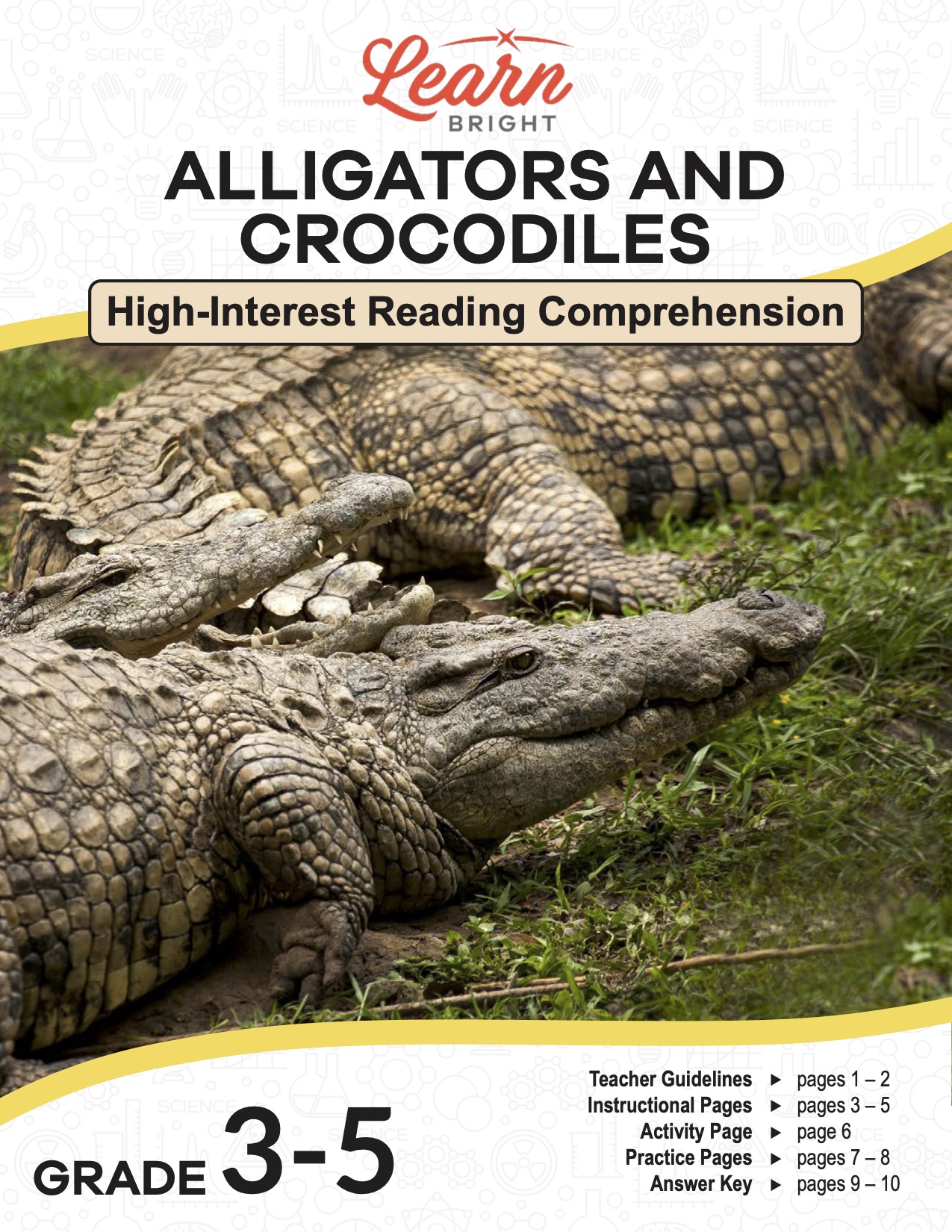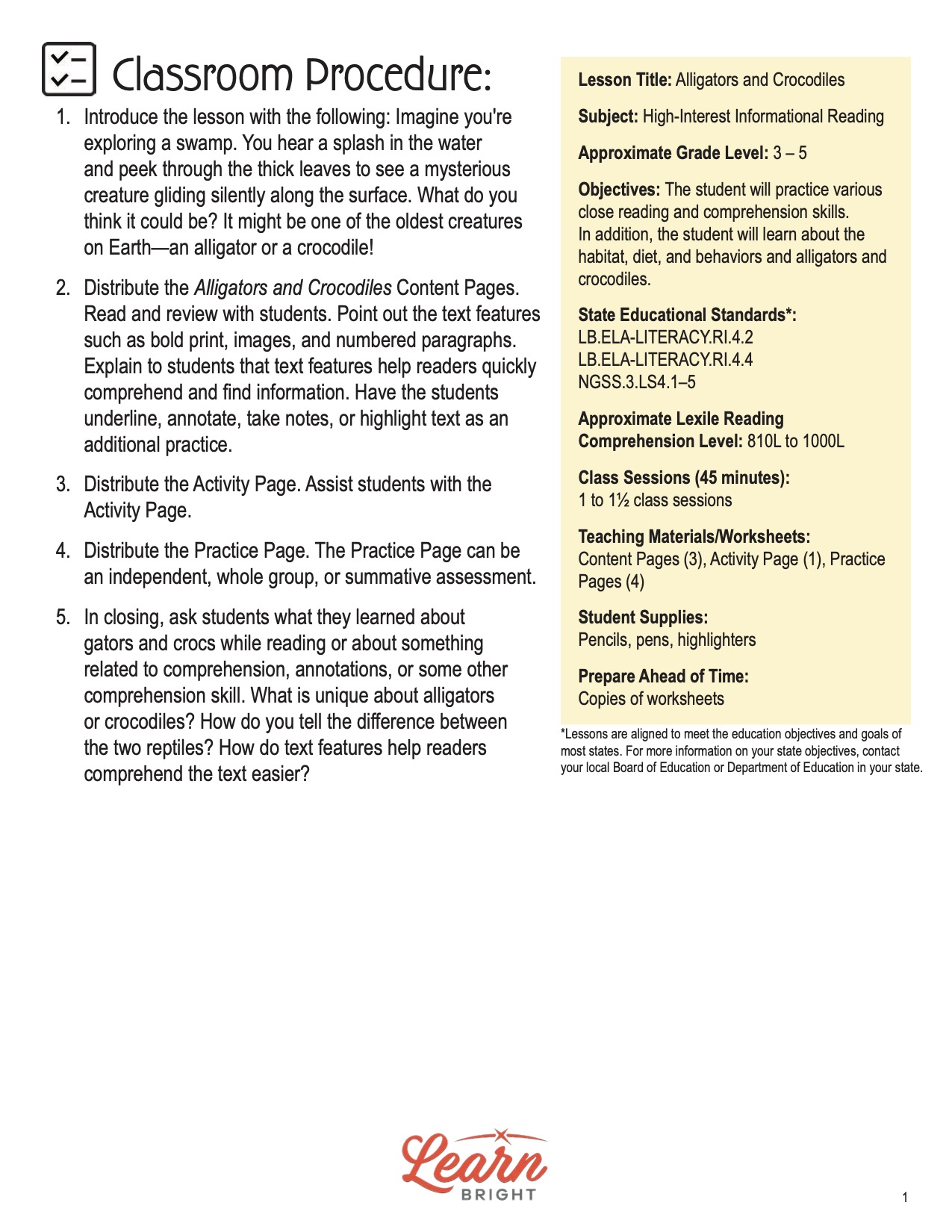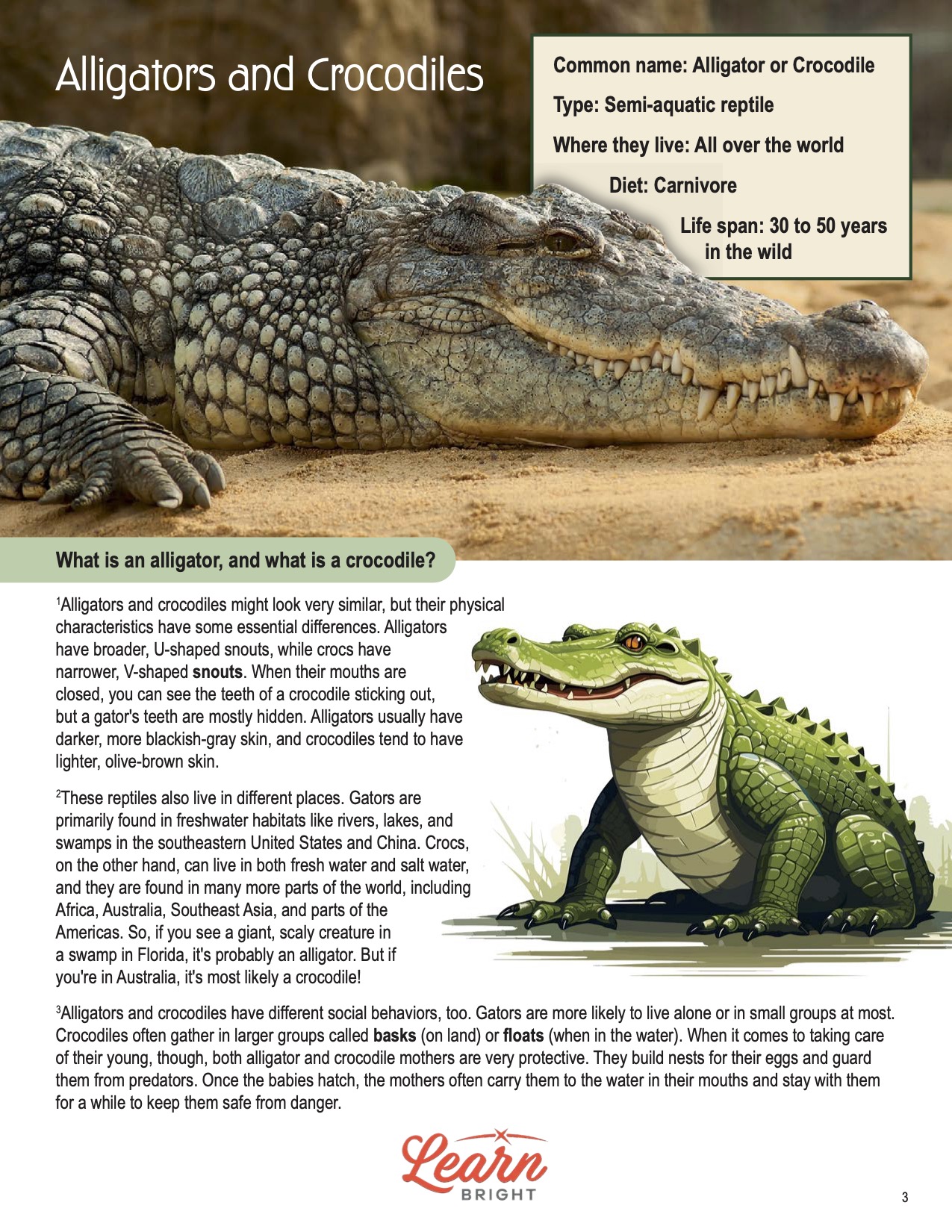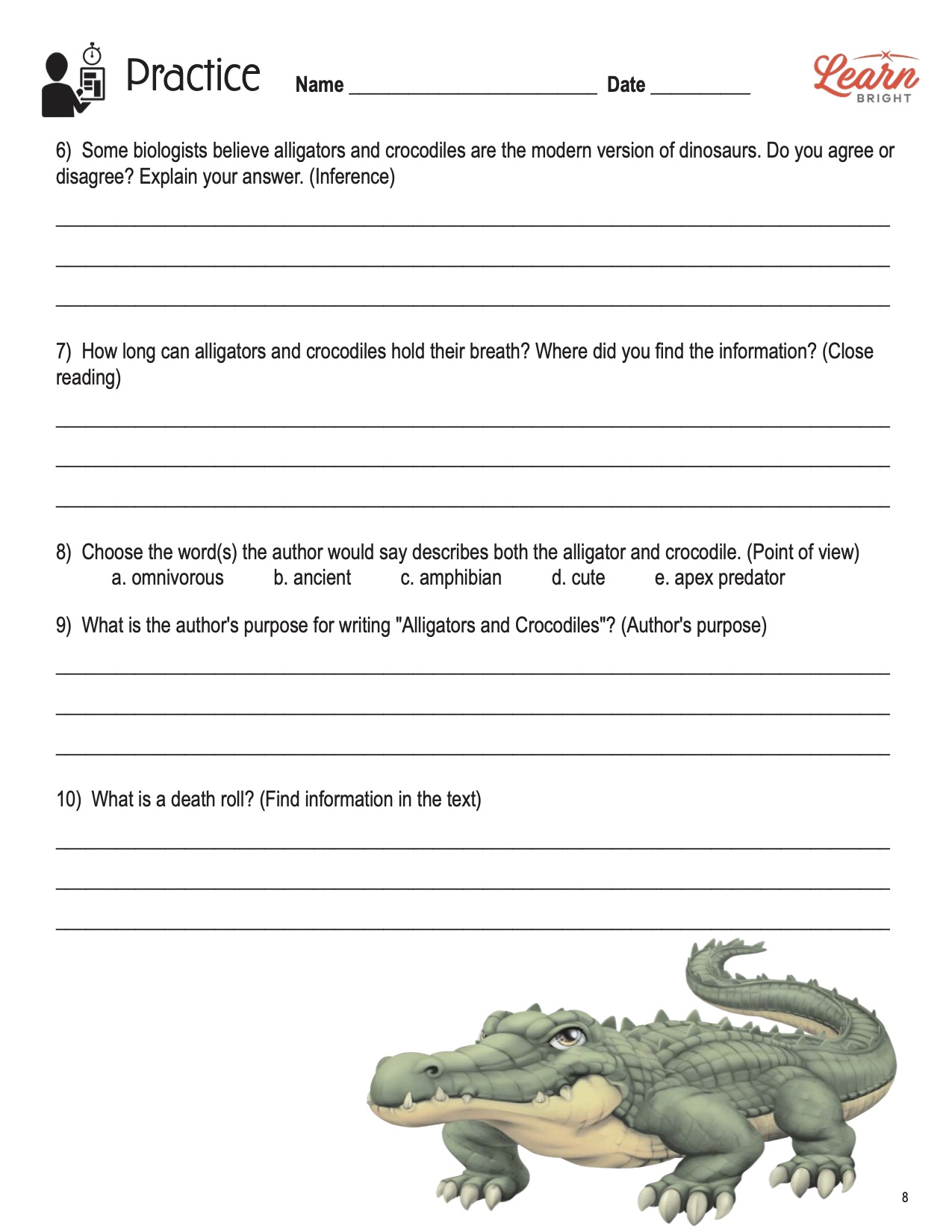Description
What our Alligators and Crocodiles lesson plan includes
Lesson Objectives and Overview: Alligators and Crocodiles is a high-interest reading comprehension lesson plan. As such, students will practice various close reading and comprehension skills. In addition, they will learn about the habitat, diet, and behaviors of these reptiles. This lesson is for students in 3rd grade, 4th grade, and 5th grade.
Classroom Procedure
Every lesson plan provides you with a classroom procedure page that outlines a step-by-step guide to follow. You do not have to follow the guide exactly. The guide helps you organize the lesson and details when to hand out worksheets. It also lists information in the yellow box that you might find useful. You will find the lesson objectives, state standards, and number of class sessions the lesson should take to complete in this area. In addition, it describes the supplies you will need as well as what and how you need to prepare beforehand.
Teacher Notes
The teacher notes page provides an extra paragraph of information to help guide the lesson. It explains that you can teach this lesson in a whole-class setting or as an independent, small-group activity. You can use the blank lines to write down any other ideas or thoughts you have about the topic as you prepare.
ALLIGATORS AND CROCODILES LESSON PLAN CONTENT PAGES
What Are Gators and Crocs?
The Alligators and Crocodiles lesson plan contains three content pages. To start off, it provides a small box with basic background information about gators and crocs. Alligators and crocodiles might look very similar, but their physical characteristics have some essential differences. Alligators have broader, U-shaped snouts, while crocs have narrower, V-shaped snouts. When their mouths are closed, you can see the teeth of a crocodile sticking out, but a gator’s teeth are mostly hidden. Alligators usually have darker, more blackish-gray skin, and crocodiles tend to have lighter, olive-brown skin.
These reptiles also live in different places. Gators are primarily found in freshwater habitats like rivers, lakes, and swamps in the southeastern United States and China. Crocs, on the other hand, can live in both fresh water and salt water, and they are found in many more parts of the world, including Africa, Australia, Southeast Asia, and parts of the Americas. So, if you see a giant, scaly creature in a swamp in Florida, it’s probably an alligator. But if you’re in Australia, it’s most likely a crocodile!
Alligators and crocodiles have different social behaviors, too. Gators are more likely to live alone or in small groups at most. Crocodiles often gather in larger groups called basks (on land) or floats (when in the water). When it comes to taking care of their young, though, both alligator and crocodile mothers are very protective. They build nests for their eggs and guard them from predators. Once the babies hatch, the mothers often carry them to the water in their mouths and stay with them for a while to keep them safe from danger.
Diet of an Alligator and Crocodile
Gators and crocs have similar diets but hunt in slightly different ways. Both of these reptiles are carnivores, which means they eat meat. They enjoy eating fish, birds, and small mammals. Sometimes, they might even eat larger animals like deer. Alligators usually hunt by lurking in the water with just their eyes and nostrils above the surface. When a prey animal approaches, the alligator snaps its powerful jaws shut with lightning speed to catch it. Crocs hunt similarly, but because they can live in fresh and salt water, they also catch animals that come to drink at the edges of rivers and lakes.
While their hunting methods are similar, there are a few differences. Alligators prefer to stay in freshwater environments and occasionally catch prey on land. Crocodiles are more versatile; they can chase their prey in water or ambush them on land, thanks to their ability to move quickly in short bursts. Both animals use their muscular tails to propel themselves silently through the water, sneaking up on unsuspecting prey. Once they catch their food, they both use the “death roll” technique. The death roll is a maneuver used by gators and crocs in which they spin their bodies rapidly to tear apart their prey into manageable pieces. By doing so, they can eat larger prey, even though they can’t chew their food.
Interesting Facts
Alligators and crocodiles both have powerful jaws. An alligator’s bite can be over 2,000 pounds per square inch, which is strong enough to crush bones! And crocs have an even more substantial bite, making them some of the most powerful predators in the animal kingdom. In addition, both animals have very sensitive snouts that help them detect even the slightest movements in the water.
If that’s not enough, these reptiles can stay underwater for a long time. In fact, they can hold their breath for up to an hour! They have particular body adaptations that allow them to slow down their heart rate and use less oxygen. That way, they can sneak up on prey or hide from danger without coming up for air. Alligators and crocodiles also have excellent night vision, thanks to a layer of cells in their eyes called the tapetum lucidum, which reflects light and helps them see in the dark.
Alligators and crocodiles are ancient animals. They have been around since the time of the dinosaurs, over 200 million years ago! This makes them some of the oldest living animal species on Earth. They are part of a group of animals called archosaurs, which includes dinosaurs and birds. And these reptiles have hardly changed over millions of years, so they are like living fossils.
Why They Are Important
Both alligators and crocodiles are important for the environment because they help keep their ecosystems balanced. They are apex predators, which means they are at the top of the food chain. By eating fish, birds, and other animals, they control the population of these species and prevent any one group from becoming too large. This helps keep the ecosystem healthy. Gators and crocs also create “gator holes” and “crocodile nests” by digging in the mud and vegetation. The holes and nests become homes for other animals, especially during dry seasons when water is scarce.
Unfortunately, some species of both reptiles are endangered, which means they are at risk of becoming extinct. This is often because of habitat loss, pollution, and hunting by humans. For instance, the American alligator was once endangered due to hunting and habitat destruction. Thanks to conservation efforts, its population has recovered. However, other species, like the Chinese alligator and the Philippine crocodile, are still in danger. It’s important to protect these amazing animals and their habitats so they can continue to play their crucial role in the environment, and future generations can see them thriving in the wild.
ALLIGATORS AND CROCODILES LESSON PLAN WORKSHEETS
The Alligators and Crocodiles lesson plan includes two worksheets: an activity worksheet and a practice worksheet. Each one will help students solidify their grasp of the material they learned throughout the lesson. You can refer to the classroom procedure guidelines to know when to hand out each worksheet.
COMPARE AND CONTRAST ACTIVITY WORKSHEET
For this activity, students will find the similarities and differences between gators and crocs. First, they will write what makes the two reptiles different from each other. Then they will write down the traits that are the same in the box at the bottom of the page.
ALLIGATORS AND CROCODILES PRACTICE WORKSHEET
The practice worksheet requires students to answer a series of 10 questions. These questions all relate to the content pages, so students will need to refer to them often for the answers. In addition, each question provides which reading tool the question corresponds to, such as text feature, vocabulary, or comprehension.
Worksheet Answer Keys
At the end of the lesson plan document is an answer key for the practice worksheet. The correct answers are all in red to make it easier for you to compare them with students’ responses. If you choose to administer the lesson pages to your students via PDF, you will need to save a new file that omits these pages. Otherwise, you can simply print out the applicable pages and keep these as reference for yourself when grading assignments.










